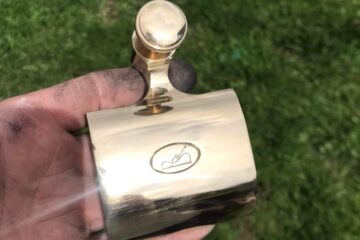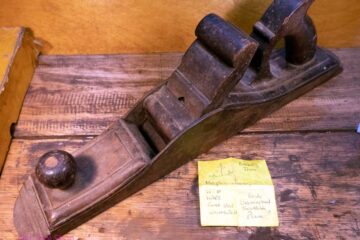We have written about how to remove rust from vintage tools and that acids and chemical cleaners should be avoided. But we have never explained why. So this article explains explains how we remove rust from vintage tools and why we use these methods. There are many options for an easy rust removal process, but are they any good? Could they harm a vintage tool or impact its value?
Our rust removal methods
We typically use hand abrasive methods to remove rust from all our metal vintage tools. These abrasive methods include scraping, brushing, sanding, wire wool and other abrasive techniques. Why don’t we save ourselves some time and use powered machines or chemicals to remove rust from vintage tools?

Powered rust removal
Machines are generally too fast and cause heat build-up. It’s too easy to make a mistake when things happen fast. And for some things heat isn’t a problem, but for some metal such as cutting edges heat can cause the properties of the metal to change. If it gets too hot and is cooled rapidly it becomes hard and brittle. Brittle edge tools chip easily and are very difficult to sharpen. If the metal gets too hot and is cooled gradually it can make the metal too soft. Although soft metal is easy to sharpen, the edge won’t be retained, and it’ll need to be resharpened more often.
It’s not that you can’t use powered methods, you just need to take care that you aren’t losing important properties of the metal in the process. We sometimes use water cooled grinding methods. These are the best of both worlds. Easy to abrade metal with no chance of excessive heat build-up.
There is a sense of dread when we find an iron or chisel that’s been through a power grinder by an unskilled hand. We hope the damage isn’t significant.
Chemical rust removal
Many people would rather drop a rusty vintage tool in a bucket of chemical than go to the effort of cleaning it by hand. Some people use acids while others use commercially available rust removal chemicals. Acids etch the metal surface and as such minute particles are removed from the entire surface, the longer you expose it to acid, the more material will be removed. If you leave it long enough in a strong enough acid there will be no vintage tool left. And once removed from acids steel will be prone to rapid rusting in air unless immediately oiled or otherwise coated.
But what about rust removal chemicals? Rust removal chemicals are often neutral rather than acidic and work on the basis of attacking only the rust. However, in the process of attacking the rust an acid is always formed. As such they are much better at preserving the underlying metal, but still rely on an essentially acidic process.
Either chemical process will change the properties of the surface metal, typically leaving a matt grey finish to iron or steel.
The differences between the methods
If you use and acids or chemicals to remove rust from your tools the acidic process will leave a very clean looking, but rather grey surface. It’ll be clean because it’ll take out all rust, dirt and detritus from the pits as well as from the surface of the steel. But is that a good thing? We don’t believe so.
Any acidic reaction will increase the size of the pits (see the diagram). Maybe with the commercial rust removers it’s only eat the pitted surfaces with rust in them, but either way it’ll still make those pits bigger. The pits now look clean, but they will soon pick up the muck again in use. And they are now bigger pits so unless you look after that tool it’ll look worse than ever.
Now, don’t get us wrong, the chemical removers are better than the purely acidic methods. They are less aggressive and are likely to do less damage to the metal beneath the rust, but they are not ideal for vintage tools. That grey finish will seriously harm any vintage tool’s value.
So what can you do about the grey surface from these acidic and chemical processes? There is no way to remove it except by abrasion, so err, then why not start there!
Abrasive rust removal methods actually make the pits smaller or in the case of the smaller pits they can be removed all together. You see abrasive methods only work on the surface metal and it leaves the pits alone. Yes, that might mean the tool’s metal has the occasional black spot here and there, but better to live with those black spots than make them worse.
In Pictures
The top image shows a hypothetical pit in a steel surface magnified many times. The second image shows what that pit would look like after the surface abrasion or polishing. You can see the abrasion only erodes the surface and doesn’t get into the pit, so the pit effectively gets smaller. The last image shows what the original pit looks like after acidic processes. Essentially all surfaces are chemically eroded so the pit gets bigger in diameter.

Conclusion
In conclusion, if you want to remove rust from vintage tools then abrasive methods are best. That method should aim to take the minimum amount of metal off the surface. We get through huge amounts of wire wool and wet and dry abrasive paper of grits 320, 600 and 1200. At the Old Tool Shop, we do the minimum amount of cleaning to bring a tool back to life and preserve its original integrity. We never try to make a tool look new. We’ll leave that to the new owner. ![]()
Click this link if you want to read more about our general vintage tool restoration methods.


